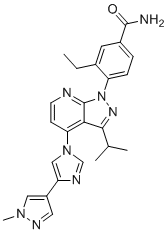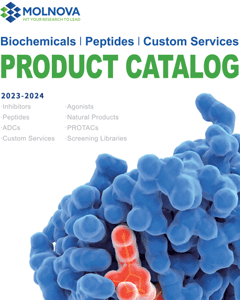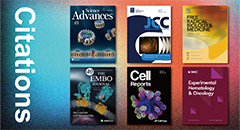
TAS-116
CAS No. 1260533-36-5
TAS-116( TAS 116 | TAS116 )
Catalog No. M11077 CAS No. 1260533-36-5
TAS-116 is a novel potent, selective, orally available HSP90α/β inhibitor with Ki of 34.7, 21.3, >50,000, and >50,000 nM for HSP90α, HSP90β, GRP94, and TRAP1, respectively.
Purity : >98% (HPLC)
 COA
COA
 Datasheet
Datasheet
 HNMR
HNMR
 HPLC
HPLC
 MSDS
MSDS
 Handing Instructions
Handing Instructions
| Size | Price / USD | Stock | Quantity |
| 5MG | 61 | Get Quote |


|
| 10MG | 87 | Get Quote |


|
| 25MG | 178 | Get Quote |


|
| 50MG | 340 | Get Quote |


|
| 100MG | Get Quote | Get Quote |


|
| 200MG | Get Quote | Get Quote |


|
| 500MG | Get Quote | Get Quote |


|
| 1G | Get Quote | Get Quote |


|
Biological Information
-
Product NameTAS-116
-
NoteResearch use only, not for human use.
-
Brief DescriptionTAS-116 is a novel potent, selective, orally available HSP90α/β inhibitor with Ki of 34.7, 21.3, >50,000, and >50,000 nM for HSP90α, HSP90β, GRP94, and TRAP1, respectively.
-
DescriptionTAS-116 is a novel potent, selective, orally available HSP90α/β inhibitor with Ki of 34.7, 21.3, >50,000, and >50,000 nM for HSP90α, HSP90β, GRP94, and TRAP1, respectively; induces cytotoxicity selectively and potently in MM cell lines and patient MM cells, without toxicity in normal PBMNCs; potently targets HSP90 client proteins including C-Raf and MEK1/2; also inhibits upregulation of HSP27 and overcomes 17-AAG resistance mechanisms in MM cells; demonstrates potent antitumor activity and minimal ocular toxicity in preclinical models.Gastric Cancer Phase 2 Clinical(In Vitro):Pimitespib binds not only to the conventional-binding pockets as existing Hsp-90 inhibitors, but also to a novel-binding pocket. Such a unique binding mode makes Pimitespib highly specific for Hsp-90α/β without inhibiting other Hsp-90 family proteins such as GRP94 in endoplasmic reticulum or TRAP-1 in mitochondria.Pimitespib (0-5 μM, 48 hours) inhibits human retinal pigment epithelial ARPE-19 cell lines and NCI-H929 MM cells growth.More significant degradation of p-C-Raf and p-MEK1/2, HSP90 client proteins and key RAS/RAF/MEK pathway regulators, is triggered by Pimitespib (0.125-1 μM, 24 hours) than 17-AAG in INA6 and NCI-H929 MM cells.(In Vivo):Pimitespib (12.0 mg/kg, p.o., 14 days) shows antitumor activity without inducing eye injury in rats. Pimitespib is distributed less in retina than in plasma in rats; consequently, Pimitespib does not produce any detectable photoreceptor injury. Pimitespib triggers enhanced in vivo anti-MM activities, both alone and in combination with PS-341 (BTZ), with a favorable safety profile. Mice treated with Pimitespib (10 mg/kg and 15 mg/kg, orally, 38 days), BTZ, or Pimitespib plus BTZ show significantly enhance growth inhibition versus the vehicle control group. Median overall survival of treated animals (Pimitespib, orally, 10 mg/kg=33 days, 15 mg/kg=37 days, BTZ=36 days, and the combination=56.5 days) is significantly longer than vehicle control.The favorable pharmacokinetic profile of Pimitespib is reflected in its dose-dependent antitumor activity; the T/C (tumor volume of Pimitespib-treated mice vs. vehicle-treated mice) is 47%, 21%, and 9% for doses of 3.6 mg/kg, 7.1 mg/kg, and 14.0 mg/kg, respectively. Pimitespib is orally absorbed and has a bioavailability of almost 100% in mice, and 69.0% in rats. Pimitespib has moderate terminal elimination half-life (t1/2=8.2 h, 2.5 h, 4.4 h and 2.2 h for mouse (3.6 mg/kg, p.o.), mouse (7.1 mg/kg, p.o.), mouse (14.0 mg/kg, p.o.), rat (4 mg/kg, p.o.)). Pimitespib is more rapidly eliminated from retina (t1/2=3.4 hours) than the other HSP90 inhibitors (t1/2=7.1-19.1 hours).
-
In VitroCell Viability Assay Cell Line:Human retinal pigment epithelial ARPE-19 cell lines and NCI-H929 MM cells Concentration:0-5 μM Incubation Time:48 hours Result:Inhibited NCI-H929 MM cells growth with an IC50 of 0.35 μM.Western Blot Analysis Cell Line:MM cell lines INA6 and NCI-H929 cells Concentration:0.125-1 μM Incubation Time:24 hours Result:Targeted potently HSP90 client proteins including C-Raf and MEK1/2; as well as inhibited upregulation of HSP27 and overcomes 17-AAG resistance mechanisms.
-
In VivoAnimal Model:Male F344 nude rats (6 weeks old) with established NCI-H1975 xenografts (6 weeks old)Dosage:12.0 mg/kg Administration:Oral administration; daily; two weeksResult:Led to tumor shrinkage. Showed antitumor activity without inducing eye injury in rats and did not cause ocular toxicity at the effective dose in the NCI-H1975 rat xenograft model.Animal Model:CB17 SCID mice (48-54 days old) with murine xenograft model Dosage:10 and 15 mg/kg Administration:Oral administration; 5 days a week; for 28 days Result:Enhanced significantly growth inhibition versus the vehicle control group. The delay in tumor growth was greater in the combination-treated group compared with either monotherapy cohort.Animal Model:Mice, Rats, and Dogs.Dosage:3.0 mg/kg for dogs, 4.0 mg/kg for rats, 3.6, 7.1 and 14.0 mg/kg for mice Administration:Oral administration; daily; 20 days Result:Absorbed orally and had a bioavailability of almost 100% in mice, 69.0% in rats, and 73.9% in dogs without special formulation.
-
SynonymsTAS 116 | TAS116
-
PathwayCytoskeleton/Cell Adhesion Molecules
-
TargetHSP
-
RecptorHSP
-
Research AreaCancer
-
IndicationGastric Cancer
Chemical Information
-
CAS Number1260533-36-5
-
Formula Weight454.538
-
Molecular FormulaC25H26N8O
-
Purity>98% (HPLC)
-
SolubilityIn Vitro:?DMSO : 125 mg/mL (275.01 mM)
-
SMILESO=C(NCC)C1=CC=C(N2N=C(C(C)C)C3=C(N4C=C(C5=CN(C)N=C5)N=C4)C=CN=C32)C=C1
-
Chemical Name3-Ethyl-4-[3-(1-methylethyl)-4-[4-(1-methyl-1H-pyrazol-4-yl)-1H-imidazol-1-yl]-1H-pyrazolo[3,4-b]pyridin-1-yl]benzamide
Shipping & Storage Information
-
Storage(-20℃)
-
ShippingWith Ice Pack
-
Stability≥ 2 years
Reference
1. Suzuki R, et al. Leukemia. 2015 Feb;29(2):510-4.
2. Ohkubo S, et al. Mol Cancer Ther. 2015 Jan;14(1):14-22.
3. Suzuki R, et al. PLoS One. 2015 Dec 2;10(12):e0143847.
molnova catalog



related products
-
BIIB021
A potent, selective, orally available HSP90 inhibitor with Ki of 1.7 nM for Hsp90α.
-
AMP-PCP
AMP-PCP is an ATP analogue and can bind to Hsp90 N-terminal domain with a Kd value of 3.8 μM. AMP-PCP binding favors the formation of the active homodimer of Hsp90.
-
SNX 2112
SNX 2112 (PF 04928473) is a potent, selective Hsp90 inhibitor with binding IC50 of 30 nM for both HSP90α and HSP90β.



 Cart
Cart
 sales@molnova.com
sales@molnova.com


